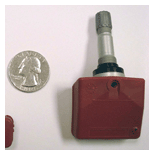This is the year of the TPMS (Tire Pressure Monitor System). It’s been coming for some time. In response to a rash of highly publicized rollover accidents caused by tire failures on SUVs, Congress passed a law called the TREAD Act in 2000 which required all vehicle manufacturers to have TPMS on all their cars and light trucks by 2008. Time has run out, and as far as we know, all the vehicle manufacturers have complied.
No one disputes the benefits of TPMS, but a hodgepodge of different technologies from various supplies means there is no common diagnostic, service or relearn procedures for these systems. The only thing they have in common is that they illuminate some type of warning light if tire pressure drops 25% or more below the recommended inflation pressure. So if a tire is supposed to carry 32 psi, the low-pressure tire warning light should come on if tire pressure drops to 24 psi or less.
 TWO TYPES OF TPMS
TWO TYPES OF TPMS
There are two basic methods for monitoring tire pressure: “indirect” TPMS systems and “direct” TPMS systems. Indirect TPMS systems do not use pressure sensors inside the tires, but instead use the wheel speed sensors that are already part of the ABS system to monitor and compare relative wheel speeds. Loss of air pressure from a tire will decrease its diameter and produce a slight change in the speed of that wheel. Indirect TPMS systems are not as sensitive as direct TPMS systems, and are used only on a few import applications (such as 2001-‘02 BMW M3, and 2003 and up BMW 3-Series, 7-Series and Z4). On the other hand, indirect TPMS causes fewer problems and requires no special service procedures when changing or rotating tires.











